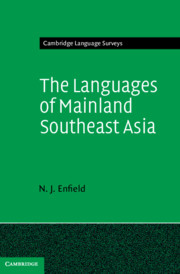Refine search
Actions for selected content:
6584 results in Grammar and Syntax
Subject Index
-
- Book:
- The Languages of Mainland Southeast Asia
- Published online:
- 22 March 2021
- Print publication:
- 01 April 2021, pp 435-438
-
- Chapter
- Export citation
Author Index
-
- Book:
- The Languages of Mainland Southeast Asia
- Published online:
- 22 March 2021
- Print publication:
- 01 April 2021, pp 429-430
-
- Chapter
- Export citation
6 - Reference and Nominal Syntax
-
- Book:
- The Languages of Mainland Southeast Asia
- Published online:
- 22 March 2021
- Print publication:
- 01 April 2021, pp 257-325
-
- Chapter
- Export citation
Contents
-
- Book:
- The Languages of Mainland Southeast Asia
- Published online:
- 22 March 2021
- Print publication:
- 01 April 2021, pp v-viii
-
- Chapter
- Export citation
Preface
-
- Book:
- The Languages of Mainland Southeast Asia
- Published online:
- 22 March 2021
- Print publication:
- 01 April 2021, pp xix-xx
-
- Chapter
- Export citation
Tables
-
- Book:
- The Languages of Mainland Southeast Asia
- Published online:
- 22 March 2021
- Print publication:
- 01 April 2021, pp xii-xviii
-
- Chapter
- Export citation
4 - Phonological Systems
-
- Book:
- The Languages of Mainland Southeast Asia
- Published online:
- 22 March 2021
- Print publication:
- 01 April 2021, pp 154-208
-
- Chapter
- Export citation
5 - Word Formation
-
- Book:
- The Languages of Mainland Southeast Asia
- Published online:
- 22 March 2021
- Print publication:
- 01 April 2021, pp 209-256
-
- Chapter
- Export citation
Acknowledgements
-
- Book:
- The Languages of Mainland Southeast Asia
- Published online:
- 22 March 2021
- Print publication:
- 01 April 2021, pp xxi-xxi
-
- Chapter
- Export citation
Language Index
-
- Book:
- The Languages of Mainland Southeast Asia
- Published online:
- 22 March 2021
- Print publication:
- 01 April 2021, pp 431-434
-
- Chapter
- Export citation
1 - Context
-
- Book:
- The Languages of Mainland Southeast Asia
- Published online:
- 22 March 2021
- Print publication:
- 01 April 2021, pp 1-37
-
- Chapter
- Export citation
Postface
-
- Book:
- The Languages of Mainland Southeast Asia
- Published online:
- 22 March 2021
- Print publication:
- 01 April 2021, pp 393-395
-
- Chapter
- Export citation
3 - Typological Overview
-
- Book:
- The Languages of Mainland Southeast Asia
- Published online:
- 22 March 2021
- Print publication:
- 01 April 2021, pp 118-153
-
- Chapter
- Export citation

The Languages of Mainland Southeast Asia
-
- Published online:
- 22 March 2021
- Print publication:
- 01 April 2021
Tables
-
- Book:
- Doing English Grammar
- Published online:
- 02 March 2021
- Print publication:
- 11 March 2021, pp xii-xii
-
- Chapter
- Export citation
Editors’ Preface
-
- Book:
- Doing English Grammar
- Published online:
- 02 March 2021
- Print publication:
- 11 March 2021, pp xiii-xiv
-
- Chapter
- Export citation
5 - Issues in Grammatical Description
-
- Book:
- Doing English Grammar
- Published online:
- 02 March 2021
- Print publication:
- 11 March 2021, pp 92-124
-
- Chapter
- Export citation
Copyright page
-
- Book:
- Doing English Grammar
- Published online:
- 02 March 2021
- Print publication:
- 11 March 2021, pp iv-iv
-
- Chapter
- Export citation
7 - Case Study 1
-
- Book:
- Doing English Grammar
- Published online:
- 02 March 2021
- Print publication:
- 11 March 2021, pp 147-167
-
- Chapter
- Export citation
6 - Grammar in Operation
-
- Book:
- Doing English Grammar
- Published online:
- 02 March 2021
- Print publication:
- 11 March 2021, pp 125-146
-
- Chapter
- Export citation
